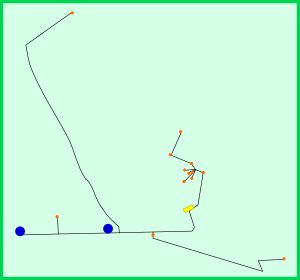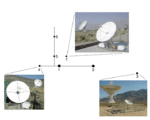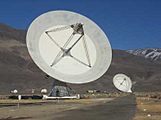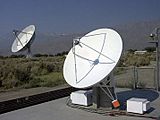Owens Valley Solar Array facts for kids
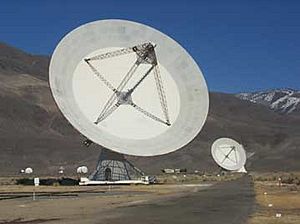 |
|
| Alternative names | OVSA |
|---|---|
| Part of | Owens Valley Radio Observatory |
| Location(s) | California |
| Coordinates | 37°14′02″N 118°17′05″W / 37.23389°N 118.28486°W |
| Organization | New Jersey Institute of Technology |
| Altitude | 1,200 m (3,900 ft) |
| Telescope style | radio telescope solar telescope |
| Website | www |
The Owens Valley Solar Array (OVSA), also known as Expanded Owens Valley Solar Array (EOVSA), is a special type of radio telescope. It is located at the Owens Valley Radio Observatory (OVRO) in Big Pine, California. Its main job is to study the Sun.
The instruments at OVSA are built to specifically observe the Sun's activities. They help scientists understand what's happening on our star. Other solar instruments at the site include the Solar Radio Burst Locator (SRBL). The New Jersey Institute of Technology (NJIT) operates the OVSA. NJIT also runs the Big Bear Solar Observatory.
Contents
History of the Owens Valley Solar Array
The California Institute of Technology (Caltech) started the Owens Valley Radio Observatory (OVRO) in the late 1950s. They used two large dishes, each 27 meters (89 feet) wide, to study distant radio galaxies. Over time, they added more and better radio telescopes.
In 1979, these two original dishes were given a new purpose. They became part of a new setup called the Owens Valley Solar Array. This array was created to focus only on observing the Sun. Professor Harold Zirin led this new project. Later, three smaller dishes, each 1.8 meters (5.9 feet) wide, were added to the array.
New Management for Solar Research
In the mid-1990s, Caltech decided to change its focus. They looked for another organization to take over the solar observatory. By 1997, the New Jersey Institute of Technology (NJIT) agreed to manage the Big Bear Solar Observatory (BBSO).
At this time, Dale Gary, a scientist working at the Owens Valley Solar Array, moved to NJIT. Because of this, the management of the Owens Valley Solar Array also moved to NJIT in 1997. In 2004, two more 1.8-meter (5.9-foot) dishes were added. This made it a 7-antenna system.
Expanding the Array
In 2010, NJIT proposed a big upgrade for the Owens Valley Solar Array. The plan was to add 8 new antennas, each 2.1 meters (6.9 feet) wide. This would bring the total number of antennas to 15. The new setup would have 13 smaller antennas arranged in a spiral shape. This spiral would spread out over 900 meters (3,000 feet).
This expansion meant moving some old antennas and building new places for them. A new control building was also planned. The National Science Foundation gave a $5 million grant in October 2010 to start this work. The project also aimed to update the control systems and wiring with newer technology. This upgrade helps scientists better understand the Sun's magnetic fields and energy releases. It also helps predict space weather.
Instruments and Discoveries
Owens Valley Solar Array (OVSA)
The OVSA uses its antennas to perform radio interferometry. This means the antennas work together to create a very detailed image. They can observe the Sun at many different radio frequencies, from 1 to 18 gigahertz. This range is known as the microwave range.
Combining detailed images with different frequencies is called microwave imaging spectroscopy. This method gives scientists a lot of information about the Sun. It can detect both normal heat radiation from the Sun's chromosphere and corona. It also picks up radiation from high-energy electrons during solar flares.
Scientists have also used OVSA to study how solar radio bursts affect wireless communication. This includes things like cell phones and the Global Positioning System (GPS). These effects are part of what we call Space weather.
- Seven-antenna layout
Solar Radio Burst Locator (SRBL)
In the 1990s, the United States Air Force needed a new system to replace its older solar telescopes. Caltech suggested the Solar Radio Burst Locator (SRBL). This system would use a new technique called "frequency agility," which was studied at OVSA.
Prototypes of the SRBL were developed at the Owens Valley Radio Observatory. These prototypes used similar technology to the OVSA system. The SRBL is a spectrometer. It uses an automated 1.8-meter (5.9-foot) dish antenna. This antenna can observe many frequencies from 610 MHz to 18 GHz. It can also observe lower frequencies using a special antenna.
The SRBL can observe the entire Sun. It can find the location of microwave bursts using just one dish. This is special because it doesn't need multiple dishes working together (interferometry). A prototype SRBL antenna has been working at the Owens Valley Radio Observatory since 1998. In 2005, the Korean government helped fund improvements to create the Korean-SRBL.
See also
- Owens Valley-related topics
- List of solar telescopes



